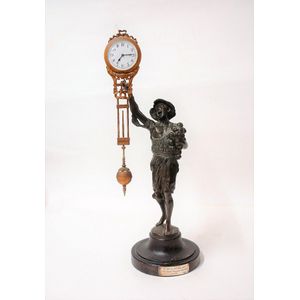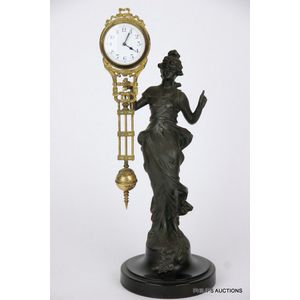Art Nouveau Diana Mystery Clock
You must be a subscriber, and be logged in to view price and dealer details.
Subscribe Now to view actual auction price for this item
When you subscribe, you have the option of setting the currency in which to display prices to $Au, $US, $NZ or Stg.
- Spelter - Spelter was the name given to an alloy of zinc and brass or copper used in the 19th century for statuary and lighting. It is a brittle bluish-white metal. It was used as a cheap replacement for bronze, but being brittle easily breaks and can't be repaired. When finished it can often be mistaken for bronze, but if discreet a scratch on the base displays shows a greyish colour, the metal is spelter, if a golden colour the metal is most likely bronze.
- Art Nouveau Period - The Art Nouveau period was a cultural movement that emerged in the late 19th century, and was characterized by its emphasis on natural forms, flowing lines, and a decorative, ornamental style. Art Nouveau was a reaction against the ornate and heavily stylized designs of the previous era, and sought to create a new, more organic aesthetic.
Art Nouveau was characterized by its use of sinuous, curving lines, as well as a focus on natural elements such as flowers, vines, and other organic shapes. Art Nouveau designers sought to create a total work of art, in which every element of a building or object was designed to be harmonious with the overall design.
Some of the most iconic examples of Art Nouveau design include the Paris Metro entrances designed by Hector Guimard, the works of the artist Alphonse Mucha, and the architecture of Victor Horta in Brussels.
The Art Nouveau period was at its peak between 1890 and 1910, but began to decline in popularity by the start of World War I. However, Art Nouveau remains an important influence on design and art to this day, and continues to be celebrated for its emphasis on natural forms and decorative style. - Circa - A Latin term meaning 'about', often used in the antique trade to give an approximate date for the piece, usually considered to be five years on either side of the circa year. Thus, circa 1900 means the piece was made about 1900, probably between 1895 and 1905. The expression is sometimes abbreviated to c.1900.
This item has been included into following indexes:
-
clocks, type
- Art Nouveau 89
- mystery 74
- Junghans Uhren GmbH (Germany) - clocks and watches 92
Visually similar items

Art Nouveau mystery clock modelled as a classical lady, on a timber base. Height 34 cm

A 19th century figured mystery clock, the bronzed young boy fruit seller modelled with open mouth as if calling attention to his fruit, his clothes ripped and torn, his right hand supporting the traditional gilt framed clock, the ebonised base with silver

A figural mystery clock in the 19th century manner. Marked with the letter 'J' (Junghans)within a star, the clock having a white enamel dial and Arabic numerals and set within a pierced and decorative brass pendulum style mount and attached with pins to th

A 19th century French figural spelter mystery clock, in the form of a French maiden (Liberty), her hand holding the clock support, the gilt framed clock and adjustable pendulum pivoting on twin pins. Good working order and patina. Height 34 cm.
